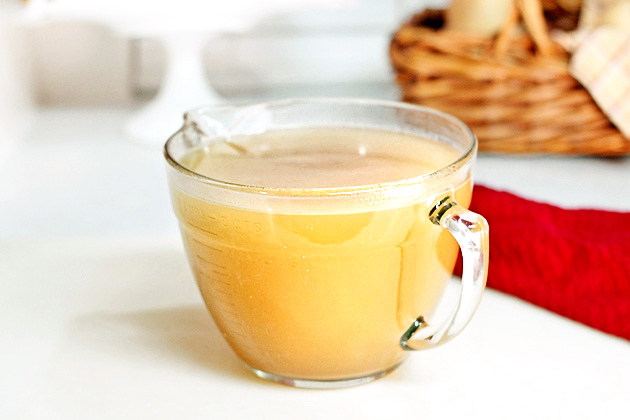
Stock is an essential ingredient and a secret to great cooking. A good stock is necessary to make soups, sauces, gravies (among many other things) that really shine. Sure, you can grab a box or can of “stock” or broth from your local grocer, but it seriously pales in comparison to the real thing. Not to mention that they are almost always loaded with sodium.
It used to be that when I heard or read the word “stock” I would think, “Oh, come on! Who has that kind of free time? I can’t stand around all day tending a stockpot. I have a life, people!” It’s true that making stock the traditional old-school way takes many hours. Yes, the results are worth it, but that doesn’t change the fact that most normal folk don’t have that kind of time.
I recently stumbled upon a method of making stock that reduces the stock cooking time to a mere hour. At first I thought that this would be akin to making a great prime rib in a microwave. Then, once I researched and pondered it further I realized that it actually produces a better product. How’s that? I’m glad you asked.
Stock is literally all about creating a flavorful liquid by wringing flavor and nutrients from the ingredients. This usually entails simmering bones, veggies, herbs, and seasonings in water for several hours. You have to simmer it long and slow in order to allow all of the good stuff to be released. You should avoid boiling a stock because the violent bubbling breaks down the ingredients and produces an overly cloudy product.
Enter the pressure cooker. The magic of a pressure cooker is that the sealed environs allow the boiling point of water to be raised significantly above the usual 212 degrees. This causes foods to cook much quicker while retaining more of their nutrients. Additionally, because the water never boils, there is no violent bubbling. Think of it as turbo-boiling in still water. It’s a beautiful thing.
Here, let me show you how this works.
Caution: Pressure cookers can be dangerous, so please make sure you read and heed the manufacturer’s instructions and warnings. (If you don’t have a pressure cooker, I have a great tip at the end of the post that involves a stockpot, the oven, and no stirring.)
First, we need to roast the turkey parts. Sure, you can use a carcass of a previously-roasted bird, but I find this to be far easier, better, and more consistent. I use one package of wings (about three pounds).
Preheat your oven to 350ºF.
Using a cleaver or large knife, carefully cut each wing at each joint. I discard the tips.
Season the wing pieces with kosher salt and pepper.
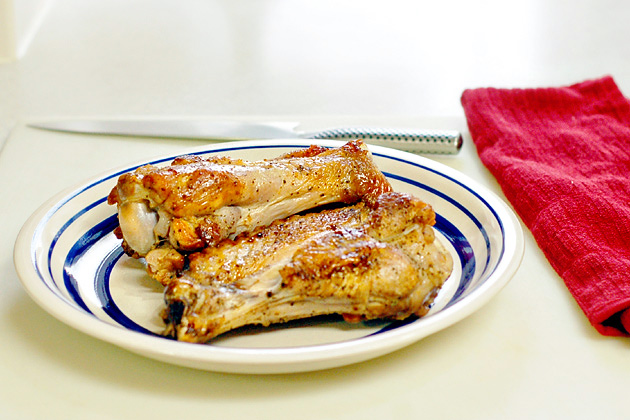
Roast the turkey parts on a sheet pan for 90 minutes, then remove them from the oven and let cool to room temperature or refrigerate for up to three days.

In addition to the roasted turkey parts, you’ll need three large carrots, three stalks of celery, one medium (or two small) yellow onion, ten sprigs of thyme, two bay leaves, a tablespoon of minced garlic, half a teaspoon of black peppercorns, and three quarts of cold water.
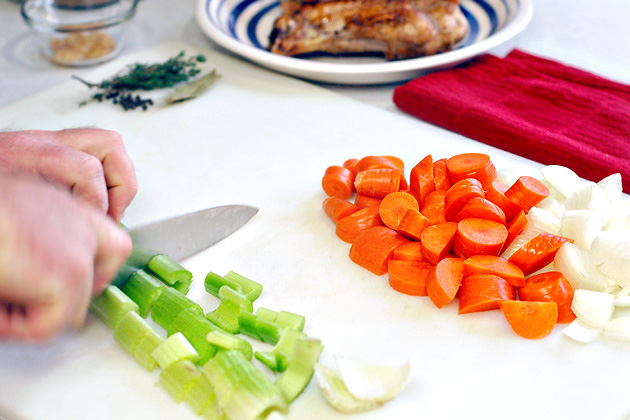
Clean the carrots (there’s no need to peel them), celery, and peel the onions.
Rough chop all of the vegetables. The size doesn’t really matter, just chop them up.
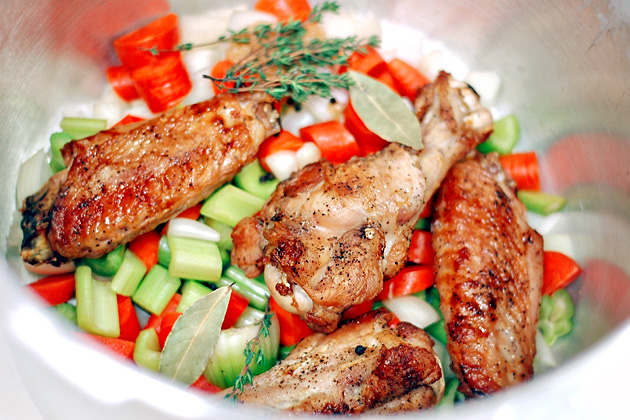
Dump everything in your pressure cooker.
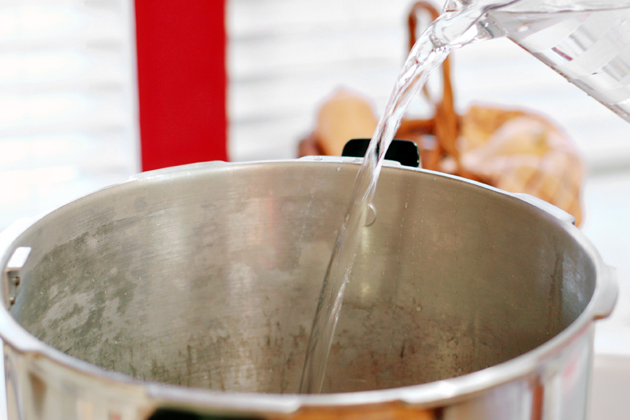
Add the water.
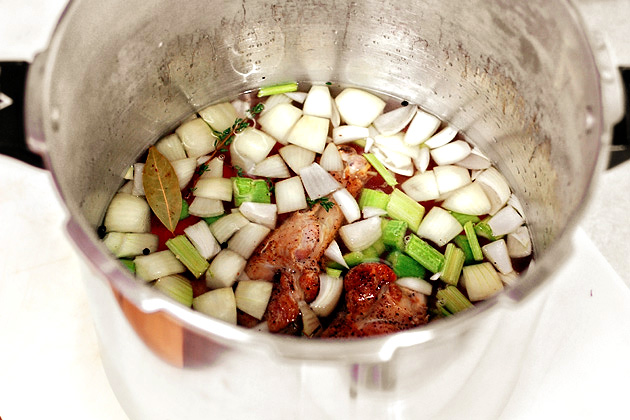
You want to just barely cover the ingredients, so add more or less water as needed.
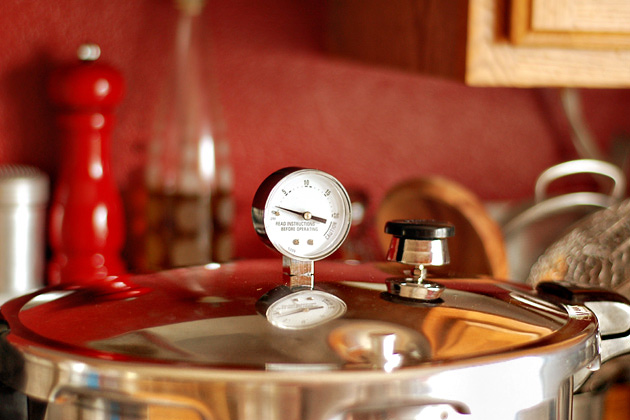
Seal your pressure cooker per the directions and bring to 15 pounds of pressure.
Reduce the heat as needed to maintain a pressure of 15 pounds and cook for 45 minutes.
Remove the cooker from the heat and let it cool until the pressure is completely relieved.
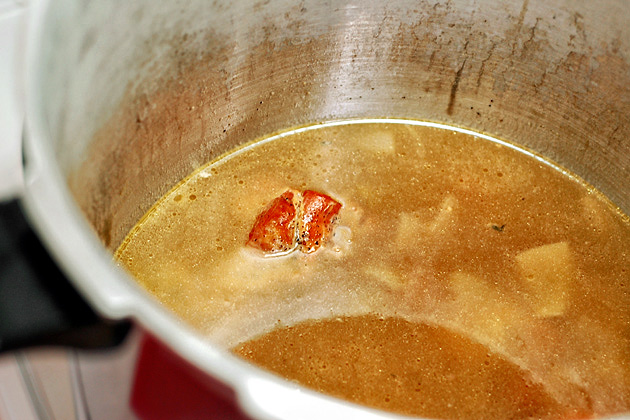
Open the cooker and remove the large pieces of meat, bone and vegetables with a large slotted spoon.
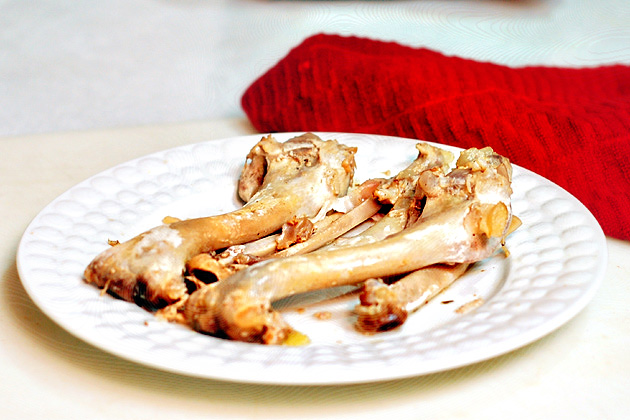
You can see what a great job the pressure cooker does. The meat completely falls off the bone with almost no effort. Our dog really appreciates this part (the leftover meat, not the bones).

Filter the stock through a very fine strainer and cool immediately. If you want a clearer stock, filter it through a colander that is lined with a clean kitchen towel. I used this batch to make gravy, so I didn’t care about it being a little cloudy. Now that I think about it, I rarely care.
Once the stock is cold, you can easily remove the solidified fat from the top.
Store in the refrigerator for up to four days, or freeze for long-term storage.
Use as needed.
Enjoy!
Notes:
1. You can use this recipe to make other types of stock, like chicken or beef. Just use those meats and bones in lieu of the turkey. For example, you can use a cut-up roasted deli chicken to make chicken stock, or use cut-up beef back ribs (roasted just like the turkey) to make beef stock. When making beef stock, I would add 2 tablespoons of tomato paste for added richness.
2. If you don’t have a pressure cooker, just use a large covered stock pot. Bring it just barely to a boil, then move the covered pot to a 180-degree oven for six hours. There is no need to stir or tend it at all.
Printable Recipe
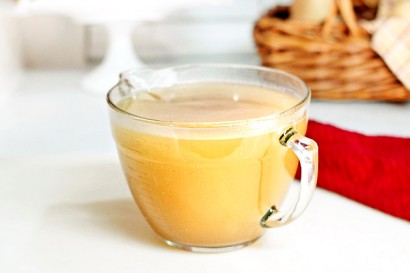
Description
Here’s a much easier way to make a great quality stock in a fraction of the time that it typically requires. This recipe will also work well with other kinds of stock.
Ingredients
- 1 package Turkey Wings (about Three Pounds)
- 3 whole Large Carrots
- 3 stalks Celery
- 1 whole Medium Yellow Onion (or Two Small)
- 10 sprigs Thyme
- 2 whole Bay Leaves
- 1 Tablespoon Garlic, Minced
- ½ teaspoons Black Peppercorns, Whole
- 3 quarts Water, Cold
Preparation Instructions
Preheat your oven to 350 degrees.
Using a cleaver or large knife, carefully cut each wing at each joint. I discard the tips.
Season the wing pieces with kosher salt and pepper.
Roast the turkey parts on a sheet pan for 90 minutes, then remove them from the oven and let cool to room temperature, or refrigerate for up to three days.
In addition to the roasted turkey parts, you’ll need three large carrots, three stalks of celery, one medium (or two small) yellow onion, ten sprigs of thyme, two bay leaves, a tablespoon of minced garlic, half a teaspoon of black peppercorns, and three quarts of cold water.
Clean the carrots (there’s no need to peel them), celery, and peel the onions.
Rough chop all of the vegetables. The size doesn’t really matter, just chop them up.
Dump everything in your pressure cooker.
Add the water.
You want to just barely cover the ingredients, so add more or less water as needed.
Seal your pressure cooker per the directions, and bring to 15 pounds of pressure.
Reduce the heat as needed to maintain a pressure of 15 pounds and cook for 45 minutes.
Remove the cooker from the heat and let it cool until the pressure is completely relieved.
Open the cooker and remove the large pieces of meat, bone and vegetables with a large slotted spoon.
Filter the stock through a very fine strainer and cool immediately. If you want a clearer stock, filter it through a colander that is lined with a clean kitchen towel. I used this batch to make gravy, so I didn’t care about it being a little cloudy. Now that I think about it, I rarely care.
Once the stock is cold, you can easily remove the solidified fat from the top.
Store in the refrigerator for up to four days, or freeze for long-term storage.
Use as needed.
Enjoy!
Notes:
* You can use this recipe to make other types of stock, like chicken or beef. Just use those meats and bones in lieu of the turkey. For example, you can use a cut-up roasted deli chicken to make chicken stock, or use cut-up beef back ribs (roasted just like the turkey) to make beef stock. When making beef stock I would add 2 tablespoons of tomato paste for added richness.
* If you don’t have a pressure cooker, just use a large covered stock pot. Bring it just barely to a boil, then move the covered pot to a 180-degree oven for six hours. There is no need to stir or tend it at all.
_______________________________________
John Dawson has always been one of our favorite men here at Tasty Kitchen. His blog, Patio Daddio BBQ is a great resource for great recipes of every kind. Go visit his site for good food, equipment reviews, cooking competitions, video clips, and occasional photos of his lovely family.

















58 Comments
Comments are closed for this recipe.
Victoria on 1.29.2011
heh heh heh, maybe I should have read all the way through the comments before posting. I will google my model right now.
Victoria on 1.29.2011
I have a pressure cooker, but it’s an Italian model (Aeternum) and there is no weight gage (??)/ way to tell how many pounds of pressure the pot is under…. is 15 pounds of pressure somewhat standard? On the lower or higher end? I’m just trying to figure out how I can make this recipe work without knowing exactly how much pressure the pot in under.
patiodaddio on 1.19.2011
Wendy – To be safe, you really should consult the manual. Just Google it up.
Wendy Hogan on 1.15.2011
I have a pressure cooker that is smaller than yours shown and without a gauge. I guess its about the size of a 4-6 qt pot. The only thing on top is a little knob that sits on top and jiggles. So far I’ve only used it for vegetables. I don’t have a manual.
If you can would you tell me how long/what heat level/how do I know when it gets up to pressure? thank you, w
lisamichele on 1.13.2011
Jenie – Most pressure cookers should have a “rocker” that sits on top of the vent pipe…they are weighted to allow different amounts of pressure. I think most pressure cookers have a 15lb rocker, but your manual might tell you.
Erika – I have the same pressure canner used in this article, it has a “button” that pops up when the canner comes up to pressure, so you know not to open it, and I’ve seen other pressure cookers that have the same thing and will actually lock the lid so you can’t open it till the pressure drops. Possibly if your grandma’s pressure cookers are older, they might not have this safeguard.
Jenie Rainey on 1.11.2011
I have an electric pressure cooker and it has no gauge for how much pressure is being added. Do you know how to adapt this recipe?
Erika on 1.9.2011
I like the idea of the pressure cooker. I wanted one so that I could fix the kind of food my grandma always did in hers. Since she had two, I got one. Well, I didnt realize how quickly they could build up pressure and I opened it after the lid had been locked for “only” 5 minutes…I was 8 months pregnant, the top blew off and I had hot stew all over my stove, kitchen, floor and ceiling…not to mention the burns I got on my hands and forearms! Luckily the lid didn’t hit me! I gave that contraption back to her the next time I went for a visit! But yours looks good!
kimeril on 1.9.2011
I have been making my own Turkey Stock for Thanksgiving for 29 years. My mother-in-law taught me only she didn’t roast the turkey parts. I started doing that about 10 years ago and it made all the difference in the world. Don’t skip that step. My family insists I make the corn bread dressing and of course the gravey because of my stock. It can be done up aheat and even frozen.
Beth on 1.9.2011
I love this recipe for making my own stock. I recently bought a Fagor 8 qt pressure cooker and so far, I have made soup, chili and a pot roast dinner in it. I was worried about putting bones in it (we made ham and bean soup but was concerned about adding the bone…guess that was unwarranted.
Rachel on 1.8.2011
I make chicken stock overnight in my crackpot regularly and have had great results. Sometimes I start with a whole raw bird and after 2 hours or so, take it out and harvest the meat off for potpies or whatever, then return the bones to the pot and add the veggies and herbs at that point, then let it rip overnight or even longer (24 hours is fine)
I’ve found that starting with a raw bird makes a more gelatinous stock than sing pre-roasted bones (though I do save all of my bones and use them too, just a slightly different result). Also organic and naturally raised poultry makes a far superior result than icky factory farmed birds.
Adding some braggs cider vinegar to the pot before starting, when the water is still cold, and allowing that to sit for 30 min to an hour before starting to cook also helps bring more minerals out of the bones and increase your gelatin.
Alice Birchfield on 1.7.2011
I just got my new baby pressure cooker from the UPS man yesterday.
I used to have a big one, but sold it before I moved.
I treated myself to a 6 qt Presto stainless steel cooker. I am looking forward to some fresh stock (no MSG!).
I can’t wait to hear the “ch ch ch” sound.
Wendy on 1.7.2011
Excellent! I have a pressure cooker that I really don’t know what to do with it. Now I can make stock. Thank you.
Frances Berg on 1.7.2011
It is ” colder than a well-diggers butt”. Good ole Oklahoma saying! Actually it is OK here today, but gearing for tomorrow and next week. Osage County can be cold this time of year, as you know! Love your recipes and fun on your site!
Valerie on 1.7.2011
I use our rotisserie chicken carcasses to make stock with onions , celery and carrots. Can usually cook it down twice. I also save the roasted veggies I put under my chickens when iIbake them in the oven . When I make stock I throw in some of the roasted veggies too. I will have to try it in the pressure cooker. I’m sure the beef stock would be much better in there.
patiodaddio on 1.6.2011
Anna – It’s 180 degrees Fahrenheit. You want it to stay just below a boil for a long time. At 180* C (356* F) it would be seriously rockin’.
Grandma Gwen on 1.6.2011
Thank you so much for inspiring me to make delicious & nutritious homemade stock! I, too, love my pressure cooker & learned to use it from my mom!
Frieda on 1.6.2011
Great post! I did this for the first time in my 2 quart pressure cooker with a leftover Costco chicken. Pressure cooked on high for 45 minutes and it was soooooo good!
You can freeze this stock! I put 2 c. in freezer baggies and now I have fresh chicken stock ready anytime. It is so easy to do; a real forehead slap moment for me. Check my post and let me know what you think: http://tinyurl.com/2ebn3ph
Cindy on 1.6.2011
The entire time I grew up my mother made stock this way. She’d do it because she made homemade Chicken and noodles for Sunday dinner. Every week. Our home was loud and ‘raucous’ due to the 8 kids running around in all directions. Mom would make this in a huge pressure canner, shed strain all the solids out, the pressure canner then became the vessel for all the homemade chicken and noodles. Sometimes she’s make dumplings from scratch and float them on top of the hot stew.
Her dumpling recipe was an old one her mother and grandmother used. You would measure the eggs, then use the shell half to measure everything else into the dumpling mix. I never did figure out how she did it. This brings back so many memories of sunday dinners at home as a child. Thank you.
Anna Magga on 1.6.2011
Being a European I am never quite sure with your measurings and degrees, and since I don’t own a pressure cooker I am more interested in the oven idea. So here comes my question: Is it 180 degrees Fahrenheit or Celcius?
Best wishes and thank you for your recipe
beth on 1.5.2011
Loved the idea of making stock in the oven..and cleaning the dirty pan at the same time!
Crockpot stock is the way we do it here: small uncooked frying chicken, lots of veggies and peppercorns, bayleaves, 2T vinegar…set to low before I go to bed…next day I add fresh parsley before shutting it off and straining it. Put it in fridge right away and wait a day so that all fat may be taken off the top.
Add to cooled stock: tortellini, spinach, chopped carrots, celery and onion, some garlic, garbanzo beans..and shrimp. Delish!
patiodaddio on 1.5.2011
Sarah – I didn’t perceive that you were attacking. You’re certainly entitled to your opinion, and I was just offering mine. I was using the stock for turkey noodle soup, which is rustic/cloudy anyhow, so I wasn’t worried about it. As for it looking granulated, that’s just the picture. I ran it through a very fine mesh strainer.
Paula Clark on 1.5.2011
Well, for goodness sakes. Your stock went from being cloudy to down right granulated. LOL It looks very good to me and I make a lot of stock in the crock pot or pressure cooker. I never could get over the price of store bought stock that didn’t taste good anyway. I don’t strain either.
Sarah B. on 1.5.2011
I don’t care how my food looks like per se, but a granulated looking stock is not very appetizing and yes, I am a homecook. I never meant for my comment to be taken as attack, but whatever.
Mary C. on 1.5.2011
I love my pressure cooker and you have inspired me to use it in a new way! Thanks
Thanks
patiodaddio on 1.5.2011
More Q&A:
Q: …that stock is incredibly cloudy. Maybe it should strained through cheesecloth and degreesed like consome afterwards?
A: Strain it if you want/need it more clear. I mentioned that I rarely care about it being cloudy. I cook for normal folks, not a five-star restaurant.
Q: Where do you get turkey parts?
A: They are readily available year-round at our local grocery stores.
Q: Do you ever add in parts such as neck or giblets?
A: Yep, you can add anything from the beek to the feet.
Q: Why not let the oven do the work while I work…or nap?
A: Exactly!
Serve at Once on 1.5.2011
I’ve never heard of letting the stock sit in the oven, but I’m definitely going to try it. Why not let the oven do the work while I work…or nap? Thanks!
Thanks!
Patty Paulsen on 1.5.2011
I never thought to use my pressure cooker to make stock–so I am adding this to my list of techniques and tools that I cannot do without.
I have a pressure cooker–two in fact–a huge one that I used to employ for canning way back when I did that sort of thing, and a smaller one that I use mainly to quickly cook tough cuts of meat or my delicious, crowd pleasing venison stew. Either way, I am sold on your method.
One question, where do you get turkey parts? I can usually only find turkey breasts, or occassionally, the market will carry drumsticks. Also, do you ever add in parts such as neck or giblets?
Sandy on 1.5.2011
I learned this from my husband (!) who NEVER discards turkey remains. Every time we cook chicken or turkey, the bones, skin scraps, everything but the giblets (he hates them) go into a big pot with the veggies. After simmering for a LONG time, he strains the soup, returns the meat to the pot adds rice and makes the best soup ever.
We call it turkey carcass soup, but it’s really stock … plus.
Emily on 1.5.2011
I always make stock on the stove – just throw the carcass of last night’s roast chicken in a large pot, cover with water and simmer away for hours. I don’t really find it takes much “tending” at all, just a peep every now and then to make sure the water’s not getting too low. Then strain, refrigerate overnight so it sets into a gel, making it much easier to portion into ziploc bags and freeze. This method actually looks like MORE work, and I’m quite dubious about the health benefits of pressure cooking. I’ve read a lot of things that strongly recommend never using a pressure cooker because of how much it kills nutrients…
Frances - grew up with pressure cookers on 1.5.2011
Glad you posted this Daddio. We’ve used the same old pressure cookers for about 30 or 40 years. Just change the rubber gasket at the hardware store as needed. Ours has no gauge on top. We were taught to use them as kids so, really, no one should fear them — Unless they do not read the instructions.
To shave off 90 minutes, do what we do, saute the turkey necks and wings etc. in the pressure cooker with oil, onion whatever. Gives it that nice golden color and roasted flavor but without dirtying another item.
Also, do not throw away your first batch of bones and veggies. Add more water and continue making batches. What happens is, the calcium gets leached from the bones with each succeeding batch. Bone broths are a great way, esp for women, to have natually absorbing calcium for their bones.
Note that with each new batch using the same ingredients, you’ll get a lighter and whiter batch as the bones yield more nutrition. We usually do about 3 and then put the batch residue into our city’s compost bin.
Fresh herbs are best but do not hesitate if all you have are dried. We mostly use dried herbs due to time factors. Just rub them vigorously between your hands as you put them in the pressure cooker. This brings out the oils and enhances flavor. The heat does the rest.
Stainless steel is not as pricey as you think. Aluminum is extremely unhealthy, esp for the brain. Avoid aluminum in cooking at all times. The extra money stainless costs is just cheap health insurance. Think of it that way. Prevention.
Wishing everyone a healthy and happy 2011.
Sarah B. on 1.5.2011
I do not mean for this to sound bitchy, but that stock is incredibly cloudy. Maybe it should strained through cheesecloth and degreesed like consome afterwards?
mnheather on 1.5.2011
I love homemade stock! I think people who throw away a perfectly good carcus are just plain crazy…
One thing I do, is I keep a ziplock in the freezer where I keep leftover bits of veggies, tops or greens from my veggies, onion peels, etc…and use that to season my stock – works perfect and I dont have to waste! Oh, and my secret ingredient? Radishes!
Mary S on 1.5.2011
This is how I make my stock. It’s so fast and easy! Thanks for sharing.
Pamela on 1.5.2011
I’ve been wracking my brains trying to decide what to tell my family to get me for my 50th birthday and I think you’ve helped me decide. A pressure cooker!! My family loves soup and stews and truly the stock is the foundation of a good one. Thanks for the great tutorial. PS – Sandi, I was thinking the same thing!! LOL!
Sandi on 1.5.2011
Look Ree! You aren’t the only one with freakishly pink alien hands!
(Love you, honey! Nice job!)
patiodaddio on 1.5.2011
Thanks for all of your kind comments. Here are my answers to the questions that have been asked so far:
Q: What brand is your pressure cooker?
A: Mine is a Presto 36-quart aluminum. I would prefer stainless steel, but I didn’t want to sell my truck to afford one.
Q: About how long would you suggest cooking if you aren’t sure of the pressure?
A: It’s hard to say, but I think you’d be fine with the recipe as-is.
Q: How much stock does this recipe make?
A: About 2 1/2 quarts.
Q: Can you make multiple batches at once?
A: I assume you’re asking if you can double the recipe. Yes, you can, as long as you have a cooker that can handle it per the instructions. Most have a maximum fill line on the inside.
Q: Can I can this stock after I make it?
A: Sure! It’s basically just soup, so can as you would soup.
KarenD on 1.5.2011
Can I can this stock after I make it? Either Pressure Cook or Water Bath?
nancypants on 1.5.2011
Good stuff! My Mom always throws the onions skins right in there with it as it improves the color (she likes it darker). :^) I also like the idea of doing it in the crockpot. I have always just done it in the stockpot.
I do hope you mean your dog likes the meat that falls off and not the bone. They aren’t ever supposed to have cooked bones. :^/
kandyce on 1.5.2011
I make stock all the time! After making my own stock for a couple years, I can’t buy stock or soup from the store anymore. I don’t use a pressure cooker though, just a regular o’l stockpot. I throw in the ingredients and tend to other things around the house. I freeze my stock in ice cube trays, too. It’s so convenient!
Lee on 1.5.2011
I love my pressure cooker! My crock pot runs a close second. With the pressure cooker I can have a great meal done in usually less than an hour.
Janis on 1.5.2011
I just bought my husband the Cusinart electric pressure cooker and I can’t wait to try this out. It couldn’t be easier.
Misty S on 1.5.2011
I have wolf gang pucks electric pressure cooker! That this is AWESOME so much safer and easy to use. I’ve made many many dinners in it. Nothing beat putting a frozen whole chicken in there, and an hour later its falling apart and moist.
Angie on 1.5.2011
Thanks for the recipe!
I have that Pampered Chef bowl! It was a freebie because my order qualified me for a free item. I use it all the time!
Ashley on 1.5.2011
I made stock in the crockpot. After I roast a chicken, I clean it and put the carcass in the crockpot. Add whatever veggies and spices you like, cover with water, add the lid, and cook on low all night. Turn it off in the morning, strain it out, and you have stock. Requires no tending at all.
Steph on 1.5.2011
Hi John!
Thanks for posting this. I picked up a used pressure cooker at a yard sale last year, and haven’t found a good enough reason to try using it yet. I have two questions.
1.) How much stock does this recipe make?
2.) Can you make multiple batches at once?
Thanks again!
Robin on 1.5.2011
We have a pressure cooker but it doesn’t have the guage on it. About how long would you suggest cooking if you aren’t sure of the pressure?
Also, someone else mentioned making stock in the slow cooker. Would love to have that recipe tool.
Thanks,
Robin
Heather (Heather's Dish) on 1.5.2011
i really need to get on the pressure cooker bandwagon…it seems like such a cool way to cool amazing food!
MOV on 1.5.2011
I enjoyed this piece. Thank you for your tips. Maybe I won’t be so lazy and just buy stock anymore.
Always an inspiration!
*
http://mothersofbrothersblog.blogspot.com
*
MOV
Sandie on 1.5.2011
I have an electric pressure cooker. I LOVE it. Much safer than a stove pressure cooker.
Jean F on 1.5.2011
Thanks for posting this!
I need to use my pressure cooker more. I dragged it out and used it last week for beans and wondered why I don’t use it more.
Have a great day!
Meme, the newer ones have safety mechanisms to keep them from exploding. The key is to keep your eye on the cooker and get to know it’s quirks and noises.